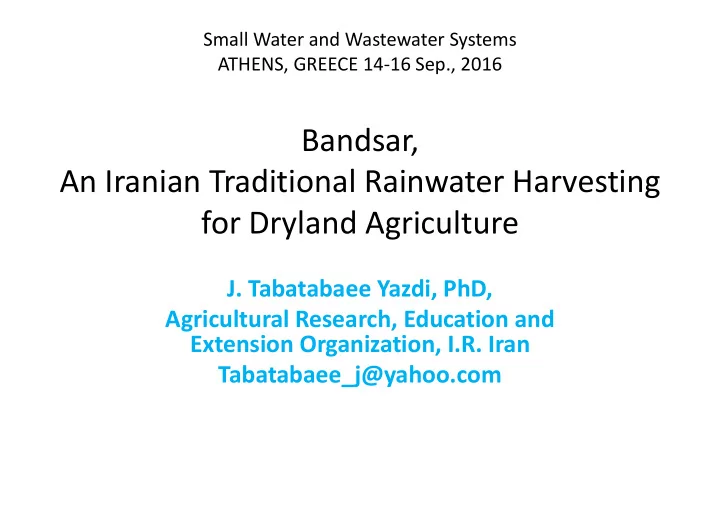

Small Water and Wastewater Systems ATHENS, GREECE 14 ‐ 16 Sep., 2016 Bandsar, An Iranian Traditional Rainwater Harvesting for Dryland Agriculture J. Tabatabaee Yazdi, PhD, Agricultural Research, Education and Extension Organization, I.R. Iran Tabatabaee_j@yahoo.com
98,9 Rain (mm) 43,4 43,4 2,2 Aut. Win. Spr. Sum.
What is Bandsar? Rock catchment Seasonal stream Bandsar
Bandsar components and How it works: 1: main stream, 2: Bandsar inlet, 3: Conveying channel, 4: Levee, 5,7: subsidiary weir and wall, 6: End side weir
Types of Bandsar: 1 ‐ Harvesting water from 2 ‐ Harvesting water from one side two sides
Types (cont.): 3 ‐ Harvesting water directly from upstream catchment
Construction: Earthmoving by hand tools to shape levees and channels
Operation: Bands may be near or faraway from the main stream Main stream Main stream Conveying Channel Bansar Bansar
Operation (cont.): Field is plowed for maximum infiltration to happen Bansar’s levee Farming land
Operation (cont.): Shelter to save farmers against cold weather and wildlife
Operation (Cont.): Conveying channels are stabilized with local shrub (Vitex pseudo – negundo)
Operation (Cont.): evee’s spacing and dimension is selected for most regular water distribution
Operation (Cont.): Sediment transported into the Bandsar improves soil texture and fertility
Utilization: Cereal and summer crops are main products
Utilization (cont.): er products are: Almond, cumin, peas and herbs
Utilization (cont.): e weeds grown in bansar during drought period is used for animal feeding
Destructive Factors: Expanding irrigated agriculture
Destructive factores (Cont.): nd mining along stream Road passing through bed bansar
Destructive factores (Cont.): e’s break down due to piping, erasion and overtopping
Destructive factores: Changing river morphology
Maintenance: Sediment removal and Levees’ heightening
Some of the experienced Bansar owners
Conclusion • Easy implementation and maintenance compared to irrigated lands • Higher productivity compare to rainfed agriculture • Animal manures and crop residue carried into Bansar increase soil’s porosity and texture. • Chemical fertilizer is not needed (It is reported that factors such as phosphate have been increased by 3 to 17 times in bansar)
Conclution (Cont.) • No pressure on fragile groundwater resources. • Applicable in a wide range of the country’s remote area (It allows those living in a desert environment adjacent to a mountain watershed to create a large oasis in an otherwise stark environment) • Less water losses by evaporation and contamination along downstream marshlands and deserts. • Rural employment (Labor and raw material can be collected from surrounding places)
Clip: Floodwater harvesting
Operation: Water is trapped in the upstream side and excess water is directed into the next basin via levees’s end points
Recommend
More recommend